096. Greater Flamingo Phoenicopterus roseus (Grootflamink)
Order: Phoenicopteriformes. Family: Phoenicopteridae
The Greater Flamingo was previously considered conspecific with the brighter coloured Caribbean flamingo, Phoenicopterus ruber, but the two are now considered separate species.
Description
127-140 cm. A large, long legged bird. The Greater Flamingo is mostly white with red only on its wings, white to pale pink plumage, contrasting red shoulders, and black tips to the wings. In flight, shows brilliant red patches in the forewings. Non-breading birds have whiter plumage. The legs are pink, the eyes yellow, and the beak is pale pink, with a black tip and a distinctive downward bend.
The female is smaller than the male.
The juvenile is grey-brown with paler underparts. The bill is pale bluish-grey with black tip. The eyes are dark. Legs and feet are grey.
Similar species: The Greater Flamingo often mixes with flocks of the Lesser Flamingo, but can be distinguished by its larger size, paler plumage, lighter beak, and pink rather than dark red legs. It differs from Lesser Flamingo in being paler pink, and in having a pink (not dark red) bill with a black tip. The Lesser Flamingo's deep-keeled bill filters minute blue-green algae and diatoms from the water, while the Greater Flamingo's shallow-keeled bill has coarser filters to strain small invertebrates.
Distribution
The most widespread flamingo species, the Greater Flamingo occurs across Africa, southern Europe, the Middle East, and into southern and southwestern Asia. In southern Africa, it is locally abundant along the coast of Mozambique, in southern Zimbabwe, central and southern Botswana, northern and western Namibia and central and south-western South Africa.
Habitat
Shallow freshwater lakes and pans.
Diet
It mainly eats small invertebrates, such as brine shrimps (Artemia), brine flies (Ephydra), molluscs and diatoms. In muddy flats or shallow water, they use their long legs and webbed feet to stir up the bottom. They then bury their bills, or even their entire heads, and suck up both mud and water to access the tasty morsels within. A flamingo's beak has a filter-like structure to remove food from the water before the liquid is expelled. Shrimplike crustaceans are responsible for the flamingo's pink color.
Breeding
Monogamous, although it changes its mate each breeding season, breeding in colonies with hundreds to thousands of nests. Hundreds of them perform a spectacular courtship display in which they march in the same direction while flapping their wings and outstretching their necks. The nest is built mainly by the male at first, while the female starts to assist him in the run up to the egg-laying season. It consists of a mound of dry or damp mud, with a shallow depression in the centre, about 15-45 cm high. It is often built on top of an older nest. Egg-laying season starts in November, peaking from January-February, although egg-laying may continue in waves until August. It lays a single chalky-white egg, rarely two, which is incubated by both sexes for roughly 27-31 days. The chicks are brooded for the first 3-4 days of their lives, leaving the nest at 5-10 days old to join a crèche along with other Lesser and Greater flamingos of similar age. It is fed by both parents with a glandular secretion, taking its first flight at about 75-80 days old. Young flamingos are born gray and white and do not turn pink for two years. In years when wetlands and pools are dry and food scarce, flamingoes may not breed.
Call
The call is a goose-like, honking ka-haunk. Listen to Bird Call.
Status
Locally abundant resident and visitor. Highly nomadic and partially migratory, usually in large flocks. Not threatened globally, although Near-threatened in South Africa and Vulnerable in Namibia, largely due to lowering water tables at major breeding sites and collision with power lines.
Africa Wild Bird Book
Greater Flamingo Photos
096. Greater Flamingo Phoenicopterus roseus

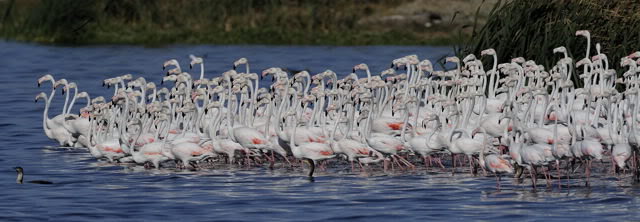

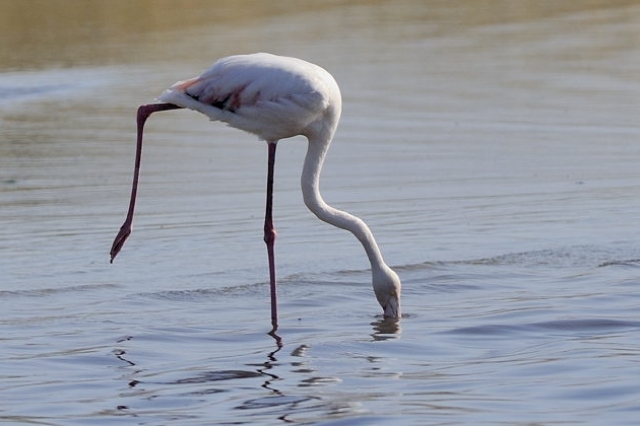
De Mond Nature Reserve © graham
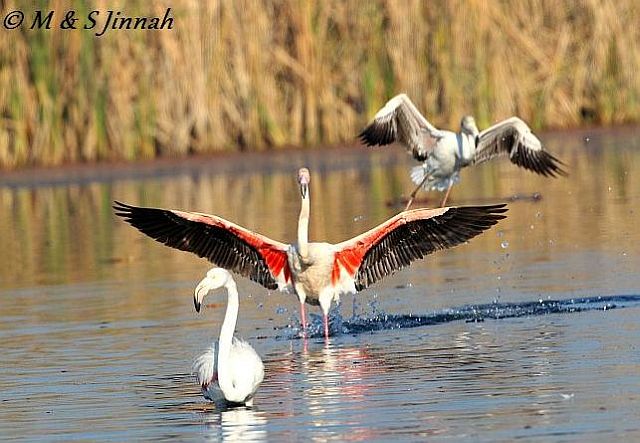 © Sharifa
© Sharifa
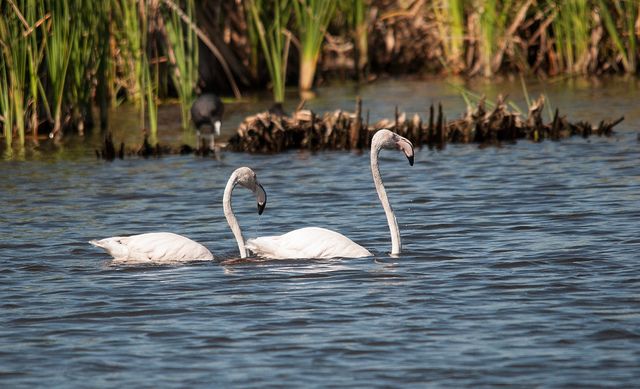 © steamtrainfan
© steamtrainfan
Marievale, Gauteng
 © nan
© nan
West Coast, March 2011
 © PRWIN
© PRWIN
Marievale, Gauteng
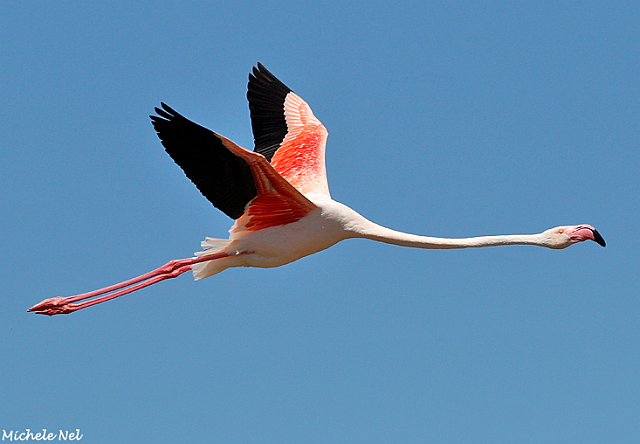 © Michele Nel
© Michele Nel
Strandfontein, Cape Town
Links:
http://sabap2.adu.org.za/docs/sabap1/096.pdf
http://sabap2.adu.org.za/spp_summary.ph ... §ion=3
http://animaldiversity.ummz.umich.edu/a ... rus_ruber/
http://www.arkive.org/greater-flamingo/ ... us-roseus/
http://www.oiseaux-birds.com/card-greater-flamingo.html




De Mond Nature Reserve © graham
 © Sharifa
© Sharifa © steamtrainfan
© steamtrainfanMarievale, Gauteng
 © nan
© nanWest Coast, March 2011
 © PRWIN
© PRWINMarievale, Gauteng
 © Michele Nel
© Michele NelStrandfontein, Cape Town
Links:
http://sabap2.adu.org.za/docs/sabap1/096.pdf
http://sabap2.adu.org.za/spp_summary.ph ... §ion=3
http://animaldiversity.ummz.umich.edu/a ... rus_ruber/
http://www.arkive.org/greater-flamingo/ ... us-roseus/
http://www.oiseaux-birds.com/card-greater-flamingo.html
ORDER PHAETHONTIFORMES
ORDER PHAETHONTIFORMES Family Phaethontidae (Tropicbirds)
The Phaethontiformes are an order of birds which contain one extant family, the tropicbirds (Phaethontidae), and one extinct family Prophaethontidae from the early Cenozoic. Several fossil genera have been described. The tropicbirds were traditionally grouped in the order Pelecaniformes, which contained the pelicans, cormorants and shags, darters, gannets and boobies and frigatebirds; in the Sibley-Ahlquist taxonomy, the Pelecaniformes were united with other groups into a large "Ciconiiformes". More recently this grouping has been found to be massively paraphyletic (missing closer relatives of its distantly related groups) and split again. Microscopic analysis of eggshell structure by Konstantin Mikhailov in 1995 found that the eggshells of tropicbirds lacked the covering of thick microglobular material of other Pelecaniformes. Some early studies in the last decade suggested Phaethontiformes were distantly related to Procellariiformes, but since 2004 they have been placed in Metaves, or in a lineage with no affinities with Procellariiformes, by the results of most recent molecular studies. Jarvis, et al.'s 2014 paper "Whole-genome analyses resolve early branches in the tree of life of modern birds" aligns the Phaethontiformes most closely with the sunbittern and the kagu of the Eurypygiformes, with these two clades forming the sister group of the "core water birds", the Aequornithes, and the Metaves hypothesis abandoned.
Tropicbirds are a family, Phaethontidae, of tropical pelagic seabirds. They are the sole living representatives of the order Phaethontiformes. For many years they were considered part of the Pelecaniformes, but genetics indicates they are most closely related to the Eurypygiformes. There are three species in one genus, Phaethon. The scientific names are derived from Ancient Greek phaethon, "sun".
Tropicbirds range in size from 76 cm to 102 cm in length and 94 cm to 112 cm in wingspan. Their plumage is predominantly white, with elongated central tail feathers. The three species have different combinations of black markings on the face, back, and wings. Their bills are large, powerful and slightly decurved. Their heads are large and their necks are short and thick. They have totipalmate feet (that is, all four toes are connected by a web). The legs of a tropicbird are located far back on their body, making walking impossible, so that they can only move on land by pushing themselves forward with their feet.
The tropicbirds' call is typically a loud, piercing, shrill, but grating whistle, or crackle. These are often given in a rapid series when they are in a display flight at the colony. In old literature they were referred to as boatswain (bo'sun'/bosun) birds due their loud whistling calls.
Tropicbirds frequently catch their prey by hovering and then plunge-diving, typically only into the surface-layer of the waters. They eat mostly fish, especially flying fish, and occasionally squid. Tropicbirds tend to avoid multi-species feeding flocks, unlike the frigatebirds, which have similar diets.
Tropicbirds are usually solitary or in pairs away from breeding colonies. There they engage in spectacular courtship displays. For several minutes, groups of 2–20 birds simultaneously and repeatedly fly around one another in large, vertical circles, while swinging the tail streamers from side to side. If the female likes the presentation, she will mate with the male in his prospective nest-site. Occasionally, disputes will occur between males trying to protect their mates and nesting areas.
Tropicbirds generally nest in holes or crevices on the bare ground. The female lays one white egg, spotted brown, and incubates for 40–46 days. The incubation is performed by both parents, but mostly the female, while the male brings food to feed the female. The chick hatches with grey down. It will stay alone in the nest while both parents search for food, and they will feed the chick twice every three days until fledging, about 12–13 weeks after hatching. The young are not able to fly initially; they will float on the ocean for several days to lose weight before flight.
Tropicbird chicks have slower growth than nearshore birds, and they tend to accumulate fat deposits while young. That, along with one-egg clutches, appears to be an adaptation to a pelagic lifestyle where food is often gathered in large amounts, but may be hard to find.
The Phaethontiformes are an order of birds which contain one extant family, the tropicbirds (Phaethontidae), and one extinct family Prophaethontidae from the early Cenozoic. Several fossil genera have been described. The tropicbirds were traditionally grouped in the order Pelecaniformes, which contained the pelicans, cormorants and shags, darters, gannets and boobies and frigatebirds; in the Sibley-Ahlquist taxonomy, the Pelecaniformes were united with other groups into a large "Ciconiiformes". More recently this grouping has been found to be massively paraphyletic (missing closer relatives of its distantly related groups) and split again. Microscopic analysis of eggshell structure by Konstantin Mikhailov in 1995 found that the eggshells of tropicbirds lacked the covering of thick microglobular material of other Pelecaniformes. Some early studies in the last decade suggested Phaethontiformes were distantly related to Procellariiformes, but since 2004 they have been placed in Metaves, or in a lineage with no affinities with Procellariiformes, by the results of most recent molecular studies. Jarvis, et al.'s 2014 paper "Whole-genome analyses resolve early branches in the tree of life of modern birds" aligns the Phaethontiformes most closely with the sunbittern and the kagu of the Eurypygiformes, with these two clades forming the sister group of the "core water birds", the Aequornithes, and the Metaves hypothesis abandoned.
Tropicbirds are a family, Phaethontidae, of tropical pelagic seabirds. They are the sole living representatives of the order Phaethontiformes. For many years they were considered part of the Pelecaniformes, but genetics indicates they are most closely related to the Eurypygiformes. There are three species in one genus, Phaethon. The scientific names are derived from Ancient Greek phaethon, "sun".
Tropicbirds range in size from 76 cm to 102 cm in length and 94 cm to 112 cm in wingspan. Their plumage is predominantly white, with elongated central tail feathers. The three species have different combinations of black markings on the face, back, and wings. Their bills are large, powerful and slightly decurved. Their heads are large and their necks are short and thick. They have totipalmate feet (that is, all four toes are connected by a web). The legs of a tropicbird are located far back on their body, making walking impossible, so that they can only move on land by pushing themselves forward with their feet.
The tropicbirds' call is typically a loud, piercing, shrill, but grating whistle, or crackle. These are often given in a rapid series when they are in a display flight at the colony. In old literature they were referred to as boatswain (bo'sun'/bosun) birds due their loud whistling calls.
Tropicbirds frequently catch their prey by hovering and then plunge-diving, typically only into the surface-layer of the waters. They eat mostly fish, especially flying fish, and occasionally squid. Tropicbirds tend to avoid multi-species feeding flocks, unlike the frigatebirds, which have similar diets.
Tropicbirds are usually solitary or in pairs away from breeding colonies. There they engage in spectacular courtship displays. For several minutes, groups of 2–20 birds simultaneously and repeatedly fly around one another in large, vertical circles, while swinging the tail streamers from side to side. If the female likes the presentation, she will mate with the male in his prospective nest-site. Occasionally, disputes will occur between males trying to protect their mates and nesting areas.
Tropicbirds generally nest in holes or crevices on the bare ground. The female lays one white egg, spotted brown, and incubates for 40–46 days. The incubation is performed by both parents, but mostly the female, while the male brings food to feed the female. The chick hatches with grey down. It will stay alone in the nest while both parents search for food, and they will feed the chick twice every three days until fledging, about 12–13 weeks after hatching. The young are not able to fly initially; they will float on the ocean for several days to lose weight before flight.
Tropicbird chicks have slower growth than nearshore birds, and they tend to accumulate fat deposits while young. That, along with one-egg clutches, appears to be an adaptation to a pelagic lifestyle where food is often gathered in large amounts, but may be hard to find.
ORDER PHAETHONTIFORMES Index
Species indigenous to southern Africa:
ORDER PHAETHONTIFORMES
Family Phaethontidae (Tropicbirds)
Phaeton rubricauda Red-tailed Tropicbird 047
Phaeton lepturus White-tailed Tropicbird 048 https://africawild-forum.com/viewtopic. ... 12#p400612
Phaethon aethereus Red-billed Tropicbird 910
ORDER PHAETHONTIFORMES
Family Phaethontidae (Tropicbirds)
Phaeton rubricauda Red-tailed Tropicbird 047
Phaeton lepturus White-tailed Tropicbird 048 https://africawild-forum.com/viewtopic. ... 12#p400612
Phaethon aethereus Red-billed Tropicbird 910
White-tailed Tropicbird
048. White-tailed Tropicbird Phaeton lepturus (Witpylstert)
Order: Phaethontiformes. Family: Phaethontidae
Description
80cm (incl. 40cm tail); 300g
Sexes alike. Smallest tropicbird and resembles the other species in its mostly-white plumage, vaguely tern-like shape, and long, tapered tail. It has a prominent yellow bill and long white central tail streamers, and a variable amount of black on the wings. Juveniles have a pale yellow bill with a black tip and the upperparts are coarsly barred with black.
Distribution
It occurs in the tropical Atlantic, western Pacific and Indian Oceans. It also breeds on some Caribbean islands, and a few pairs have started nesting recently on Little Tobago, joining the red-billed tropicbird colony. In addition to the tropical Atlantic, it nests as far north as Bermuda, where it is locally called a "longtail".
Habitat
Tropical oceans, on small, remote islands on cliffs and occasionally in trees.
Diet
It feeds on fish and squid, caught by surface plunging, but this species is a poor swimmer.
Breeding
They breed on tropical islands laying a single egg directly onto the ground or a cliff ledge. The white-tailed tropicbird does not have a yearly breeding cycle; instead breeding frequency depends on the climate and availability of suitable breeding sites. The bird can reproduce 10 months after the last successful breeding, or 5 months after an unsuccessful one.
Status
Globally, the most abundant tropicbird. Breeds in the Mozambique Channel, vagrant further south. IUCN status - least concern.
Order: Phaethontiformes. Family: Phaethontidae
Description
80cm (incl. 40cm tail); 300g
Sexes alike. Smallest tropicbird and resembles the other species in its mostly-white plumage, vaguely tern-like shape, and long, tapered tail. It has a prominent yellow bill and long white central tail streamers, and a variable amount of black on the wings. Juveniles have a pale yellow bill with a black tip and the upperparts are coarsly barred with black.
Distribution
It occurs in the tropical Atlantic, western Pacific and Indian Oceans. It also breeds on some Caribbean islands, and a few pairs have started nesting recently on Little Tobago, joining the red-billed tropicbird colony. In addition to the tropical Atlantic, it nests as far north as Bermuda, where it is locally called a "longtail".
Habitat
Tropical oceans, on small, remote islands on cliffs and occasionally in trees.
Diet
It feeds on fish and squid, caught by surface plunging, but this species is a poor swimmer.
Breeding
They breed on tropical islands laying a single egg directly onto the ground or a cliff ledge. The white-tailed tropicbird does not have a yearly breeding cycle; instead breeding frequency depends on the climate and availability of suitable breeding sites. The bird can reproduce 10 months after the last successful breeding, or 5 months after an unsuccessful one.
Status
Globally, the most abundant tropicbird. Breeds in the Mozambique Channel, vagrant further south. IUCN status - least concern.
White-tailed Tropicbird Photos
048. White-tailed Tropicbird Phaeton lepturus
 © Dindingwe
© Dindingwe
Cousin Island, Seychelles
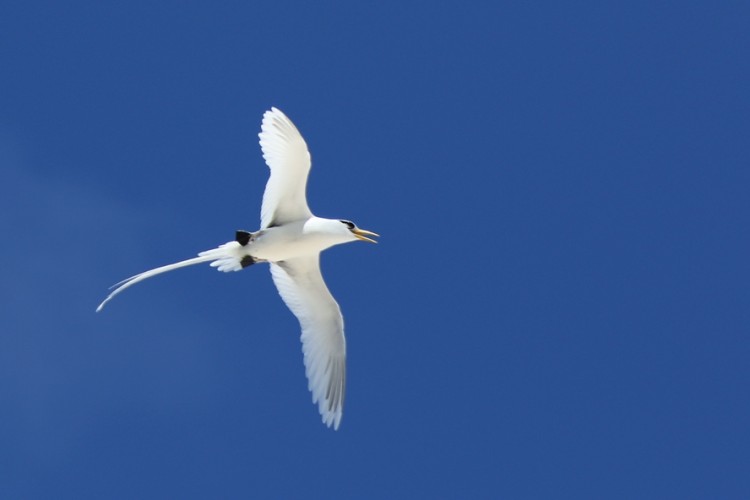 © Dindingwe
© Dindingwe
Cousin Island, Seychelles
Juvenile
 © Dindingwe
© Dindingwe
Cousin Island, Seychelles
Links:
https://en.wikipedia.org/wiki/White-tailed_tropicbird
https://neotropical.birds.cornell.edu/S ... o/overview
 © Dindingwe
© DindingweCousin Island, Seychelles
 © Dindingwe
© DindingweCousin Island, Seychelles
Juvenile
 © Dindingwe
© DindingweCousin Island, Seychelles
Links:
https://en.wikipedia.org/wiki/White-tailed_tropicbird
https://neotropical.birds.cornell.edu/S ... o/overview
ORDER CICONIIFORMES
ORDER CICONIIFORMES Family Ciconiidae (Storks)
Traditionally, the order Ciconiiformes has included a variety of large, long-legged wading birds with large bills: storks, herons, egrets, ibises, spoonbills, and several others. Ciconiiformes are known from the Late Eocene. At present the only family retained in the order is the storks, Ciconiidae.
The Family Ciconiidae belongs to the Order Ciconiiformes, and includes 19 species within six different genera.
Medium-sized to large wading birds, they have long bill, neck and legs, indicating their preference for wet habitats, even if some of them frequent mainly grassy or forested areas.
All species have almost similar appearance with relatively heavy and large body. The largest member of the family, the Marabou (Leptoptilos crumeniferus) is about 152 cm tall and can weight 8-9 Kg. For comparison, the Abdim’s Stork (Ciconia abdimii) only measures 75-80 cm and weights 1-3 Kg.
Both sexes have similar plumage, but the male is usually slightly larger than the female.
They usually are black and white with some variations such as the Yellow-billed Stork with the wings showing pinkish feathers.
The Marabou, and Lesser and Greater Adjutants have coloured neck and head. The Marabou and the Greater Adjutant have a large throat sac inflated during the courtship displays. We also can see some glossy green or purple feathers on neck, wings or back of the birds of the genus Ciconia.
In all species, the juveniles are duller and greyer or browner than adults.
The bill is the most interesting criterion of this family. It is always large, and can be really huge in some species such as the Marabou which beak grows continuously until to reach about 34-35 cm long. There are variable shapes according to the feeding behaviour.
Storks dwell in many regions and tend to live in drier habitats than the closely related herons, spoonbills and ibises; they also lack the powder down that those groups use to clean off fish slime. Storks have no syrinx and are mute, giving no call; bill-clattering is an important mode of communication at the nest. Many species are migratory. Most storks eat frogs, fish, insects, earthworms, small birds and small mammals.
Storks tend to use soaring, gliding flight, which conserves energy. Soaring requires thermal air currents. Storks are heavy, with wide wingspans: the Marabou Stork, with a wingspan of 3.2 metres joins the Andean Condor in having the widest wingspan of all living land birds.
Their nests are often very large and may be used for many years. Some nests have been known to grow to over two metres in diameter and about three metres in depth. Storks were once thought to be monogamous, but this is only partially true. They may change mates after migrations, and may migrate without a mate. They tend to be attached to nests as much as partners.
Traditionally, the order Ciconiiformes has included a variety of large, long-legged wading birds with large bills: storks, herons, egrets, ibises, spoonbills, and several others. Ciconiiformes are known from the Late Eocene. At present the only family retained in the order is the storks, Ciconiidae.
The Family Ciconiidae belongs to the Order Ciconiiformes, and includes 19 species within six different genera.
Medium-sized to large wading birds, they have long bill, neck and legs, indicating their preference for wet habitats, even if some of them frequent mainly grassy or forested areas.
All species have almost similar appearance with relatively heavy and large body. The largest member of the family, the Marabou (Leptoptilos crumeniferus) is about 152 cm tall and can weight 8-9 Kg. For comparison, the Abdim’s Stork (Ciconia abdimii) only measures 75-80 cm and weights 1-3 Kg.
Both sexes have similar plumage, but the male is usually slightly larger than the female.
They usually are black and white with some variations such as the Yellow-billed Stork with the wings showing pinkish feathers.
The Marabou, and Lesser and Greater Adjutants have coloured neck and head. The Marabou and the Greater Adjutant have a large throat sac inflated during the courtship displays. We also can see some glossy green or purple feathers on neck, wings or back of the birds of the genus Ciconia.
In all species, the juveniles are duller and greyer or browner than adults.
The bill is the most interesting criterion of this family. It is always large, and can be really huge in some species such as the Marabou which beak grows continuously until to reach about 34-35 cm long. There are variable shapes according to the feeding behaviour.
Storks dwell in many regions and tend to live in drier habitats than the closely related herons, spoonbills and ibises; they also lack the powder down that those groups use to clean off fish slime. Storks have no syrinx and are mute, giving no call; bill-clattering is an important mode of communication at the nest. Many species are migratory. Most storks eat frogs, fish, insects, earthworms, small birds and small mammals.
Storks tend to use soaring, gliding flight, which conserves energy. Soaring requires thermal air currents. Storks are heavy, with wide wingspans: the Marabou Stork, with a wingspan of 3.2 metres joins the Andean Condor in having the widest wingspan of all living land birds.
Their nests are often very large and may be used for many years. Some nests have been known to grow to over two metres in diameter and about three metres in depth. Storks were once thought to be monogamous, but this is only partially true. They may change mates after migrations, and may migrate without a mate. They tend to be attached to nests as much as partners.
Family Ciconiidae (Storks) Index
Species indigenous to southern Africa:
ORDER CICONIIFORMES
Family Ciconiidae (Storks)
Mycteria ibis Yellow-billed Stork 090
Anastomus lamelligerus African Openbill 087
Ciconia abdimii Abdim's Stork 085
Ciconia ciconia White Stork 083
Ciconia episcopus Woolly-necked Stork 086
Ciconia nigra Black Stork 084
Ephippiorhynchus senegalensis Saddle-billed Stork 088
Leptoptilos crumeniferus Marabou Stork 089
ORDER CICONIIFORMES
Family Ciconiidae (Storks)
Mycteria ibis Yellow-billed Stork 090
Anastomus lamelligerus African Openbill 087
Ciconia abdimii Abdim's Stork 085
Ciconia ciconia White Stork 083
Ciconia episcopus Woolly-necked Stork 086
Ciconia nigra Black Stork 084
Ephippiorhynchus senegalensis Saddle-billed Stork 088
Leptoptilos crumeniferus Marabou Stork 089
Yellow-billed Stork
090. Yellow-billed Stork Mycteria ibis (Nimmersat)
ORDER CICONIIFORMES. Family: Ciconiidae
Description
97 cm; 1.8 kg. Predominantly white in colour, with black edging to their wings and tails. In flight separated from White Stork by black (not white) tail. The bill is bright yellow, slightly decurved. Facial skin, legs and feet are reddish. The eyes are grey brown.
At onset of breeding, naked facial skin becomes bright red, and back and upper wing covert feathers tinged pink. During non breeding season bill duller yellow and legs dull red to pink.
Sexes alike. Immature birds have greyish brown upperparts brownish, underparts washed grey-brown with dull greyish brown bill, dull orange face and brownish legs. Adult plumage attained after about 3 years.
Distribution
Across much of sub-Saharan Africa, common or abundant in the eastern half of South Africa.
Habitat
Wetlands with shallow water for feeding, sandbanks or trees for roosting. Common in swamps, the margins of rivers or lakes, lagoons, marshes, small pools, flooded grassland, waterholes; less common on marine mudflats, in tidal pools along beaches or in estuaries.
Diet
Small aquatic prey - frogs, small fish, aquatic insects, worms, crustaceans; occasionally small mammals and birds. It does most of its foraging in shallow water without vegetation, often wading with its bill half open and immersed in the water while stirring up mud with its feet, catching any flushed by snapping its bill shut.
Breeding
Monogamous, breeding in colonies of 10-20, sometimes up to 50 nests per tree, often alongside ibises, herons, African darters, other storks (especially Marabou storks), African spoonbills and/or cormorants. The nest is built by both sexes in about 7-10 days, consisting of a platform of sticks with a shallow central cup lined with leaves, fine grass, reeds and aquatic grasses. It is typically placed on top of a tree, such as Acacia, Water fig (Ficus verruculosa) or Baobab (Adansonia digitata), roughly 3-7m above ground or water. Egg-laying season is from July-March, peaking from August-October. It lays 2-4 eggs, which are incubated by both sexes for roughly 30 days. The chicks are brooded by both parents, constantly at first but more intermittently later, while both adults provide food by regurgitation. They take their first flight at about 35 days old, leaving the nest at about 55 days old and becoming independent five days or so later, although they may return to the nest to roost up to approximately 90 days old.
Call
Usually silent. During breeding season gives loud squeaks and other notes likened to a squeaking hinge.
Status
Uncommon to locally common. Smaller resident population augmented by non-breeding intra-African nomads and migrants between October and April. Found singly but more often in pairs. Nomadic in response to water levels and fish availability. Regarded as near-threatened.
ORDER CICONIIFORMES. Family: Ciconiidae
Description
97 cm; 1.8 kg. Predominantly white in colour, with black edging to their wings and tails. In flight separated from White Stork by black (not white) tail. The bill is bright yellow, slightly decurved. Facial skin, legs and feet are reddish. The eyes are grey brown.
At onset of breeding, naked facial skin becomes bright red, and back and upper wing covert feathers tinged pink. During non breeding season bill duller yellow and legs dull red to pink.
Sexes alike. Immature birds have greyish brown upperparts brownish, underparts washed grey-brown with dull greyish brown bill, dull orange face and brownish legs. Adult plumage attained after about 3 years.
Distribution
Across much of sub-Saharan Africa, common or abundant in the eastern half of South Africa.
Habitat
Wetlands with shallow water for feeding, sandbanks or trees for roosting. Common in swamps, the margins of rivers or lakes, lagoons, marshes, small pools, flooded grassland, waterholes; less common on marine mudflats, in tidal pools along beaches or in estuaries.
Diet
Small aquatic prey - frogs, small fish, aquatic insects, worms, crustaceans; occasionally small mammals and birds. It does most of its foraging in shallow water without vegetation, often wading with its bill half open and immersed in the water while stirring up mud with its feet, catching any flushed by snapping its bill shut.
Breeding
Monogamous, breeding in colonies of 10-20, sometimes up to 50 nests per tree, often alongside ibises, herons, African darters, other storks (especially Marabou storks), African spoonbills and/or cormorants. The nest is built by both sexes in about 7-10 days, consisting of a platform of sticks with a shallow central cup lined with leaves, fine grass, reeds and aquatic grasses. It is typically placed on top of a tree, such as Acacia, Water fig (Ficus verruculosa) or Baobab (Adansonia digitata), roughly 3-7m above ground or water. Egg-laying season is from July-March, peaking from August-October. It lays 2-4 eggs, which are incubated by both sexes for roughly 30 days. The chicks are brooded by both parents, constantly at first but more intermittently later, while both adults provide food by regurgitation. They take their first flight at about 35 days old, leaving the nest at about 55 days old and becoming independent five days or so later, although they may return to the nest to roost up to approximately 90 days old.
Call
Usually silent. During breeding season gives loud squeaks and other notes likened to a squeaking hinge.
Status
Uncommon to locally common. Smaller resident population augmented by non-breeding intra-African nomads and migrants between October and April. Found singly but more often in pairs. Nomadic in response to water levels and fish availability. Regarded as near-threatened.
Yellow-billed Stork Photos
090. Yellow-billed Stork Mycteria ibis
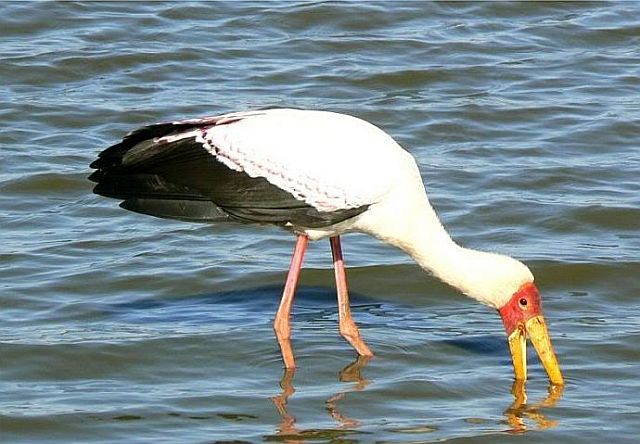 © Toko
© Toko
Non-breeding Plumage, Kruger National Park
 © leachy
© leachy
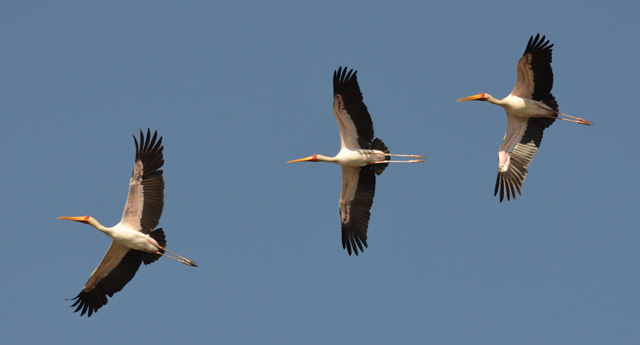 © BluTuna
© BluTuna
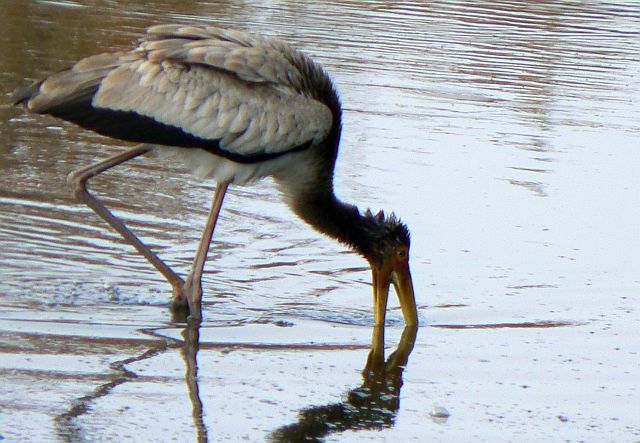 © Toko
© Toko
Juvenile
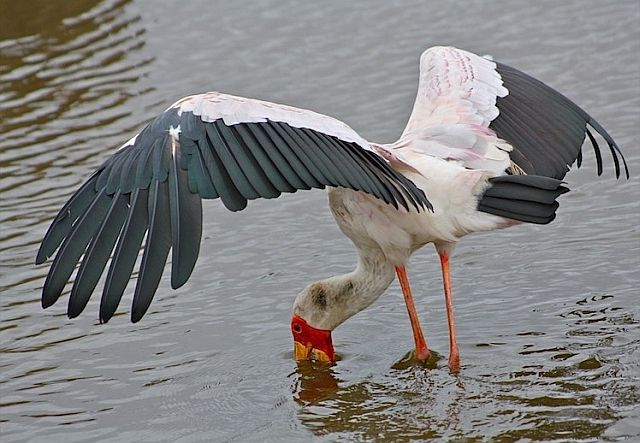 (Breeding Plumage) © ExFmem
(Breeding Plumage) © ExFmem
A feeding strategy is known as 'canopy feeding' or 'shadowing', wherein the wings are spread, creating a patch of shade which entices fish, etc. into the mock shelter. It is also thought that it is used to reduce glare.
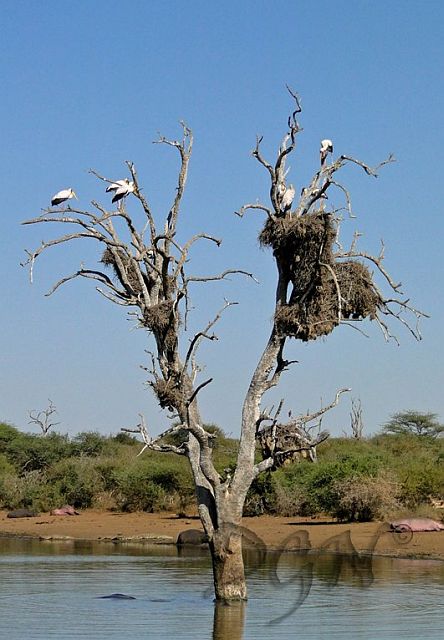 © JustN@ture
© JustN@ture
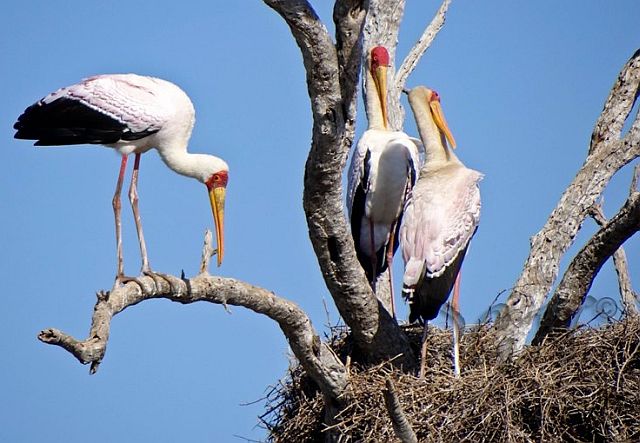 © JustN@ture
© JustN@ture
Links:
Species text Sabap1
Sabap2
James Hancock, James A. Kushlan, M. Philip KahlStorks, Ibises and Spoonbills of the World
 © Toko
© TokoNon-breeding Plumage, Kruger National Park
 © leachy
© leachy  © BluTuna
© BluTuna © Toko
© TokoJuvenile
 (Breeding Plumage) © ExFmem
(Breeding Plumage) © ExFmemA feeding strategy is known as 'canopy feeding' or 'shadowing', wherein the wings are spread, creating a patch of shade which entices fish, etc. into the mock shelter. It is also thought that it is used to reduce glare.
 © JustN@ture
© JustN@ture © JustN@ture
© JustN@tureLinks:
Species text Sabap1
Sabap2
James Hancock, James A. Kushlan, M. Philip KahlStorks, Ibises and Spoonbills of the World


